Climacteric. 2009 Sep 1:1-10.
Ziaei S, Moghasemi M, Faghihzadeh S.
Departments of Obstetrics & Gynecology.
Objective To compare the effects of tibolone with those of conventional hormone replacement therapy on climacteric symptoms and sexual function in postmenopausal women. Materials and methods In a randomized, controlled trial, 140 postmenopausal women were allocated into three groups. Of the subjects included, 47 women received 2.5 mg tibolone + one Cal+D tablet (500 mg calcium and 200 IU vitamin D) daily; 46 women received 0.625 mg conjugated equine estrogen + 2.5 mg medroxyprogesterone (CEE/MPA) + one Cal+D tablet daily; and 47 women received only one Cal+D tablet as the control group. The Greene Climacteric Scale (GCS) questionnaire was used to detect the efficacy of treatment on climacteric symptoms. Rosen’s Female Sexual Function Index (FSFI) was used for sexual function evaluation. Sex hormone binding globulin (SHBG), free estradiol index (FEI) and free testosterone index (FTI) were measured before and after treatment. The women were followed up for 6 months Results After treatment, all subscores in the GCS improved in the tibolone and CEE/MPA groups (p < 0.01), except the sexual subscore in the CEE/MPA group, compared with baseline. There were significant differences in the FSFI in the tibolone and CEE/MPA groups in comparison to the control group after treatment. Tibolone, in comparison to CEE/MPA, significantly lowered SHBG levels and increased the FTI and FEI and improved the desire, arousal and orgasm sexual domains of the FSFI (p < 0.001). Conclusion Tibolone may be an alternative to conventional hormone replacement therapy in the treatment of climacteric symptoms and sexual dysfunction in postmenopausal women.

